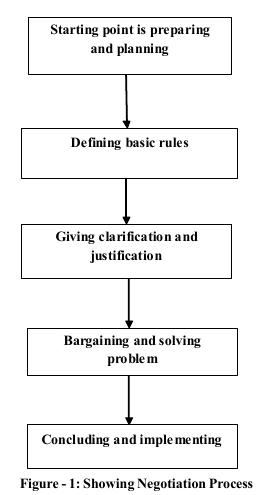Question based on Anna University Solved Assignment and other course
Answer:
Negotiation may take place anywhere maybe in big organizations, small organizations, restaurant, conference room, headquarters of military, residential area, or by the side of a road
It is said to be journey, because parties can open up new options or develop understandings completely different from what they might have imagined or considered acceptable at the start of the process of negotiation.
Negotiation is a process to achieve ones goals through communication with at least one or other party, with the assumed outcome in an agreement. When the two parties have a conflict, or have differences that may result in conflict. In negotiation, the parties have the ability to prevent each other from achieving other parties’ goal.
In negotiation process the parties explore each other’s position; they try build a relationship and seek to understand each other’s concerns. They identify the issues and familiarize themselves with the other parties negotiating approach.
They then begin a process in which they begin to move towards each other. It is a process of exchange or influences other party of negotiation. They make offers and respond to offers; they exchange information, seek to persuade the other side and each side’s stance is modified by what is learned from the other. Gradually they begin to narrow their differences; they agree on some issues and identify fresh problems. They begin to see that agreement is at hand and move towards closure.
It is important to be aware of these processes and to plan accordingly. It is also important to be aware that different strategies may be appropriate at different phases in the negotiation process. Many negotiations start off competitively, trading bids and counter-bids, but as deadlock approaches there is a shift to a cooperative stance to reach agreement.
Thus, the negotiation process mainly consists of five steps such as: Starting point is preparing and planning, defining basic rules, giving clarification and justification, bargaining and solving problem and concluding and implementing.

Source: Stephen P.Robbins, (2001), ‘Organizational Behavior’; Pearson education pg no398
- Starting Point is Preparing and Planning: Negotiation requires preparing and planning before one starts negotiating, one need to be through with the groundwork. Various questions such as nature of the conflict, reason for particular negotiation, parties involved in such negotiation and their perceptions of the conflict, what one wants from the negotiation? What kind of goal one is having. For example if management wants better out from labor and then only their wages will be raised. It means better productivity will lead to increase in wages of worker. This goal should be there in discussion of management and labor and it should not be overshadowed. It would be helpful if one puts its goal in writing and develop a variety of outcomes—from “most hopeful” to “minimally acceptable” — to keep your attention focused. One should also be prepared with the negotiating goals of other parties ,what a negotiating party will ask for, what is the position of negotiating parties and what would be settlement point for negotiating parties. Once all information is gathered one need to develop negotiation strategy. As one should be prepared for how one is going to react in a particular situation. As a part of strategy one should develop one’s own and other side Best Alternative to a Negotiated Agreement. (BATNA).It is lowest value to an individual for a negotiated agreement. One should not expect success unless one is able to make the other side an offer it finds more attractive than its BATNA.
- Defining Basic Rules: Once one is done with its planning and has developed a strategy, then the party is ready to begin defining the basic rules and procedures with the other party over the negotiation itself. Questions such as who will do the negotiation, place of negotiation i.e location, time period till which the negotiation should take place, issues to be included in negotiation, any specific procedure to be followed if an deadlock is reached. During this phase, the parties in negotiation will also exchange there.
- Giving Clarification and Justification: When parties in negotiation exchange their initial proposals or demands other party will explain, make it clear and justify others original demands, It may not be confrontational. It is an opportunity for the parties for educating and informing each other on the issues, why they have an important issue, and how each arrived at their basic demands. This is the point at which one might want to provide some documentation to other party which may support his position.
- Bargaining and Solving Problem: It is one of the very important steps where one part would try to make an effort in giving and taking to hash out an agreement. Both the parties will make some kind of compromise. Negotiating directly addresses some of the actions one should take to improve the likelihood of achieving a good agreement.
- Concluding and Implementing: This is the last step in the negotiation process in which the agreement is formalizing that which is being worked out and developing any procedures that are necessary for implementation and monitoring. For major negotiation which would include everything from labor- management negotiations to negotiating a job.
